Spring Boot RabbitMQ Default Exchange Example
In this tutorial, we’ll examine how to integrate RabbitMQ with Spring Boot applications to send and receive messages using the Default Exchange.
This is the fourth post in this series.
First part covers about Direct Exchange
Second part covers about Topic Exchange
Third part covers about Fanout Exchange
Fourth part covers about Headers Exchange
Default exchange
The default exchange is a pre-declared direct exchange with no name, usually referred by an empty string. When you use default exchange, your message is delivered to the queue with a name equal to the routing key of the message. Every queue is automatically bound to the default exchange with a routing key which is the same as the queue name.
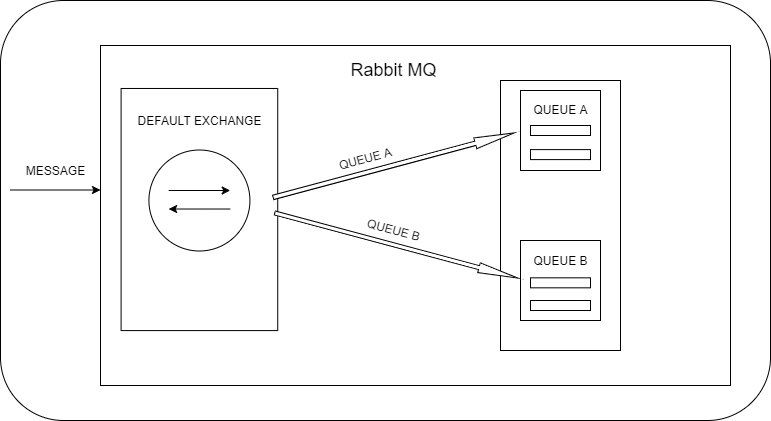
If message with routing key Queue.A is it is sent to Queue.A
If message with routing key Queue.B is it is sent to Queue.B
Setting Up Project
Go to Spring Initializr and add the following starter dependencies to a project.
- Spring Web
- Spring for RabbitMQ
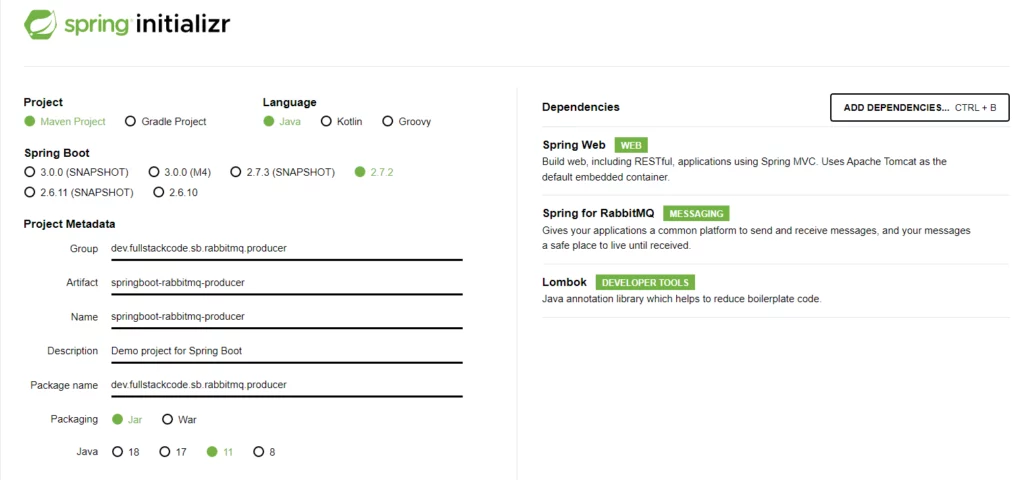
Change the Name to “springboot-rabbitmq-producer” and then click on “Generate” button. A .zip will download. Unzip it. Inside you’ll find a simple, Maven-based project including a pom.xml build file (NOTE: You can use Gradle. The examples in this tutorial will be Maven-based.)
Import the project to your favorite IDE.
Configuring RabbitMQ connection
To integrate RabbitMQ in your Spring-powered web applications, all you need to do is configure Spring to use RabbitMQ. Spring for RabbitMQ provides a convenient class called RabbitTemplate to send and receive messages
By default RabbitTemplate class uses following configuration to connect to RabbitMQ instance.
host: localhost
port: 5672
username: guest
password: guest
Using application.properties
You can also configure connection to RabbitMQ instance using application.properties.
In real world application you need configure using application properties only.
spring.rabbitmq.host=localhost
spring.rabbitmq.port=5672 (non - SSL) or 5671 (SSL)
spring.rabbitmq.username=guest
spring.rabbitmq.password=guestCode language: plaintext (plaintext)Let’s see how to setup the queues and bindings programmatically in Spring Boot application.
Default exchange pre declared exchange provided by RabbitMQ server. So no need to create it.
We create a configuration class to create queues
package dev.fullstackcode.sb.rabbitmq.producer.config;
import org.springframework.amqp.core.Queue;
import org.springframework.amqp.rabbit.connection.ConnectionFactory;
import org.springframework.amqp.rabbit.core.RabbitTemplate;
import org.springframework.amqp.support.converter.Jackson2JsonMessageConverter;
import org.springframework.amqp.support.converter.MessageConverter;
import org.springframework.boot.ApplicationRunner;
import org.springframework.context.annotation.Bean;
import org.springframework.context.annotation.Configuration;
@Configuration
public class RabbitMQConfiguration {
@Bean
Queue queueA() {
return new Queue("queue.A", false);
}
@Bean
Queue queueB() {
return new Queue("queue.B", false);
}
@Bean
Queue queueC() {
return new Queue("queue.C", false);
}
@Bean
MessageConverter messageConverter() {
return new Jackson2JsonMessageConverter();
}
@Bean
ApplicationRunner runner(ConnectionFactory cf) {
return args -> cf.createConnection().close();
}
@Bean
RabbitTemplate rabbitTemplate(ConnectionFactory connectionFactory) {
RabbitTemplate rabbitTemplate = new RabbitTemplate(connectionFactory);
rabbitTemplate.setMessageConverter(messageConverter());
return rabbitTemplate;
}
}
Code language: Java (java)Queue – beans are used to create queue
MessageConverter – is used to convert object to Json format
RabbitTemplate – is used to configure the RabbitMQ server.
In above config class , you can observe that there is no binding keys on queues and exchanges
When working with Default Queue, we do not declare any exchange and bindings as it is pre declared in RabbitMQ server and bindings are based on the queue names
Note
By default RabbitTemplate uses SimpleMessageConverter class. SimpleMessageConverter class can be used to send data in string and byte format.
You can also use SimpleMessageConverter to send json data but using Jackson2JsonMessageConverter class simplifies the work
Creating Queues on Startup
Spring Boot application connects to RabbitMQ server instance and creates Queues when first message is published . If you want your application to create Queues on application startup , you should use following method.
@Bean
ApplicationRunner runner(ConnectionFactory cf) {
return args -> cf.createConnection().close();
}Code language: Java (java)Publishing Messages
Once RabbitTemplate is configured , it is very easy publish messages. We can use overloaded send/convertAndSend method on RabbitTemplate class to publish messages.
Let’s develop a controller class which publishes messages.
package dev.fullstackcode.sb.rabbitmq.producer.controller;
import com.fasterxml.jackson.core.JsonProcessingException;
import com.fasterxml.jackson.databind.ObjectMapper;
import dev.fullstackcode.sb.rabbitmq.producer.model.Event;
import org.springframework.amqp.core.DirectExchange;
import org.springframework.amqp.core.FanoutExchange;
import org.springframework.amqp.core.HeadersExchange;
import org.springframework.amqp.core.Message;
import org.springframework.amqp.core.MessageProperties;
import org.springframework.amqp.rabbit.core.RabbitAdmin;
import org.springframework.amqp.rabbit.core.RabbitTemplate;
import org.springframework.amqp.support.converter.Jackson2JsonMessageConverter;
import org.springframework.amqp.support.converter.MessageConverter;
import org.springframework.amqp.support.converter.SimpleMessageConverter;
import org.springframework.beans.factory.annotation.Autowired;
import org.springframework.http.HttpStatus;
import org.springframework.messaging.MessageHeaders;
import org.springframework.messaging.converter.JsonbMessageConverter;
import org.springframework.web.bind.annotation.PostMapping;
import org.springframework.web.bind.annotation.RequestBody;
import org.springframework.web.bind.annotation.RequestMapping;
import org.springframework.web.bind.annotation.RestController;
import org.springframework.web.server.ResponseStatusException;
import java.util.HashMap;
import java.util.Map;
@RestController
@RequestMapping(value ="rabbitmq/event")
public class RabbitMQProducerController {
@Autowired
private RabbitTemplate rabbitTemplate;
@PostMapping
public String send(@RequestBody Event event) {
if( event.getName().equalsIgnoreCase("Event A")) {
rabbitTemplate.convertAndSend("queue.A", event);
} else if (event.getName().equalsIgnoreCase("Event B")) {
rabbitTemplate.convertAndSend("queue.B", event);
} else if (event.getName().equalsIgnoreCase("Event C")) {
rabbitTemplate.convertAndSend("queue.C", event);
} else {
throw new ResponseStatusException(HttpStatus.BAD_REQUEST,"unknown event");
}
return "message sent successfully";
}
}
Code language: Java (java)Starting the RabbitMQ
Let’s use following docker compose file for starting RabbitMQ server in local development for our testing.
version: '3'
services:
rabbitmq:
container_name: rabbitmq
hostname: my-rabbitmq
image: rabbitmq:3.10.6-management-alpine
ports:
- '5672:5672'
- '15672:15672'
Code language: Java (java)docker-compose upCode language: plaintext (plaintext)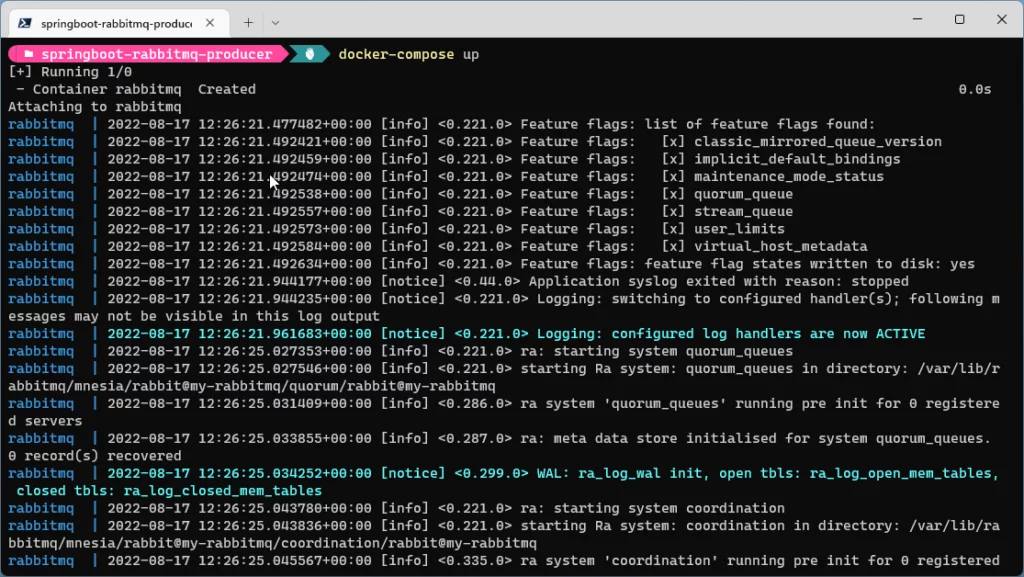
Starting Spring Boot RabbitMQ producer Application
Let’s start the springboot-raabitmq-producer application and publish some messages.
As we are connecting to RabbitMQ server on startup, it should create Queues and bindings in RabbitMQ instance.
We can check this by going to management console of RabbitMQ. It is available at
http://localhost:15672
username/password -> guest/guest
Below images confirm that queue and bindings created successfully on startup.
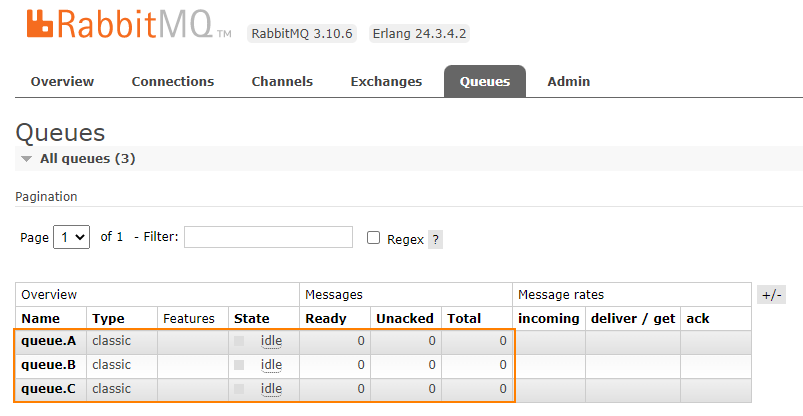
Publishing Messages
Let’s publish messages by sending request to controller class.

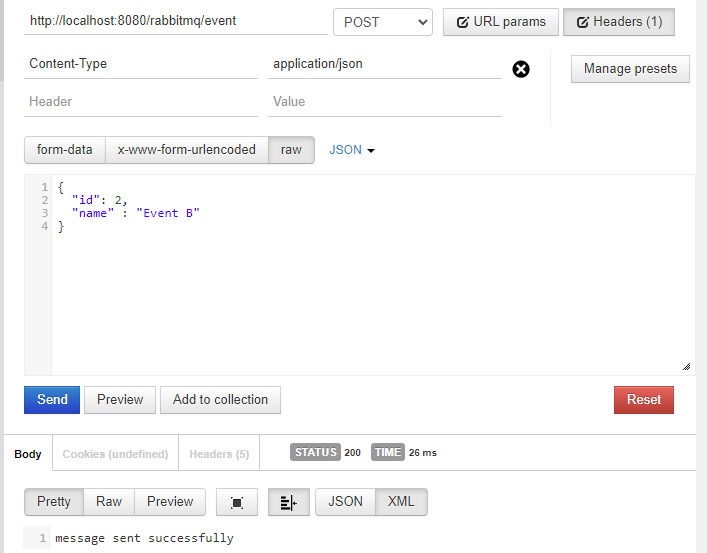
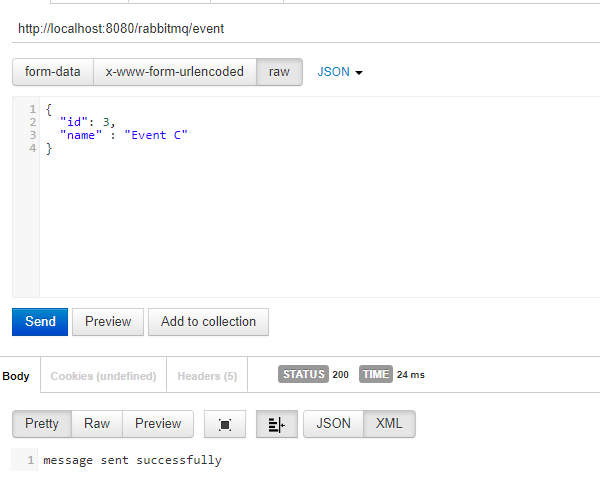
Let’s look at the management console.
Each queue has one message based on the queue name
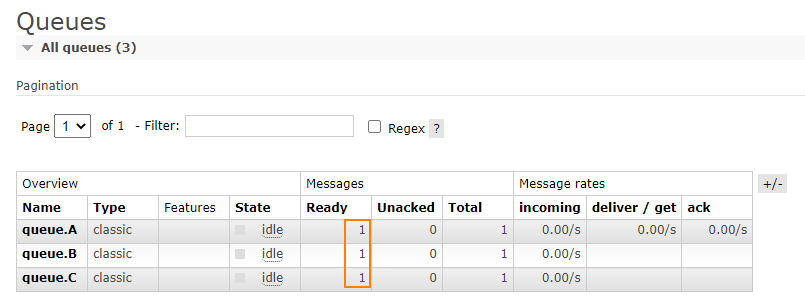
Consuming Messages
Now let’s develop a consumer application which consumes messages from RabbitMQ server.
First define MessageConverter to Convert Json String back to Object
package com.fullstackcode.sb.rabbitmq.consumer.config;
import org.springframework.amqp.support.converter.Jackson2JsonMessageConverter;
import org.springframework.amqp.support.converter.MessageConverter;
import org.springframework.context.annotation.Bean;
import org.springframework.context.annotation.Configuration;
@Configuration
public class RabbitMQConfiguration {
@Bean
MessageConverter messageConverter() {
return new Jackson2JsonMessageConverter();
}
}
Code language: Java (java)@RabbitListener annotation is used to receive messages from RabbitMQ queues.
Spring Boot will take care of converting message to corresponding Object
package com.fullstackcode.sb.rabbitmq.consumer.listener;
import com.fullstackcode.sb.rabbitmq.consumer.model.Event;
import lombok.extern.slf4j.Slf4j;
import org.springframework.amqp.rabbit.annotation.RabbitListener;
import org.springframework.stereotype.Component;
@Component
@Slf4j
public class RabbitMQConsumer {
@RabbitListener(queues = "queue.A")
private void receiveQueueA(Event event) {
log.info("Event received from queue A -> {}",event.toString());
}
@RabbitListener(queues = "queue.B")
private void receiveQueueB(Event event) {
log.info("Event received from queue B -> {}",event);
}
@RabbitListener(queues = "queue.C")
private void receiveQueueC(Event event) {
log.info("Event received from queue C -> {}",event);
}
}Code language: Java (java)Once we start the consumer application, we can see following output.
INFO : Event received from queue A -> Event(id=1, name=Event A)
INFO : Event received from queue B -> Event(id=2, name=Event B)
INFO : Event received from queue C -> Event(id=3, name=Event C)Code language: Java (java)Connecting to Remote Host
The above consumer example connects to RabbitMQ instance running in local
If you want to connect to instance running on server, you need specify the server address in application.properties
You can configureaddress like below
For SSL connection
spring.rabbitmq.addresses=amqps://<username>:<password>@<host>/<virtual-host>Code language: Java (java)For non-SSL connection
spring.rabbitmq.addresses=amqp://<username>:<password>@<host>/<virtual-host>Code language: Java (java)If you prefer individual properties, you can also configure like below
spring.rabbitmq.host=<host>
spring.rabbitmq.virtual-host=<virtaul-host>
spring.rabbitmq.port=5671 (SSL) or 5672 ( non - SSL)
spring.rabbitmq.username=<username>
spring.rabbitmq.password=<password>Code language: Java (java)Note
RabbitMQ in general listens on port 5672. If RabbitMQ instance is running on SSL, it will listen on port 5671
You can download source code from GitHub
Producer – sureshgadupu/sb-rabbitmq-defaultexchange (github.com)
Consumer – sureshgadupu/sb-rabbitmq-defaultexchange-consumer (github.com)
You might be also interested in